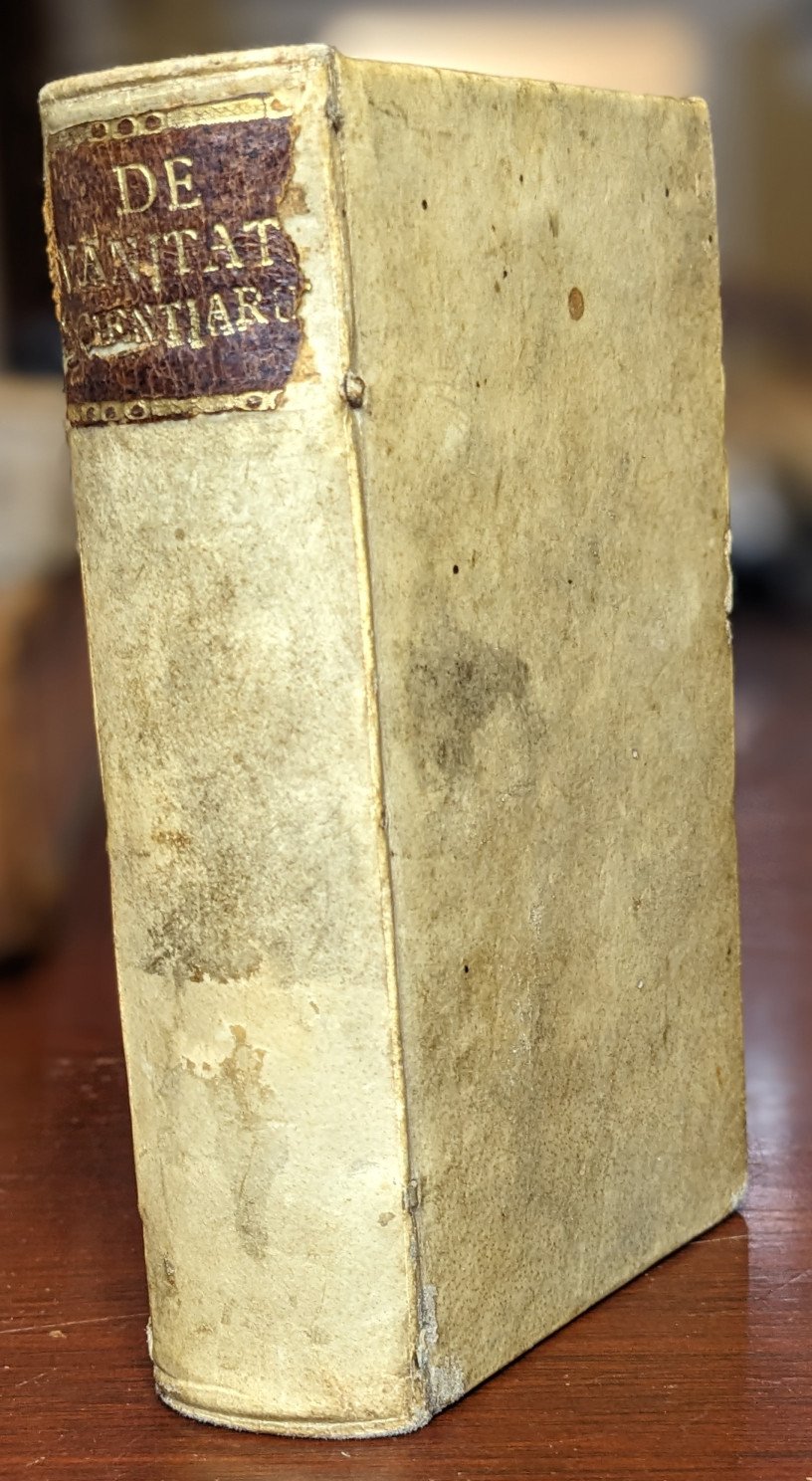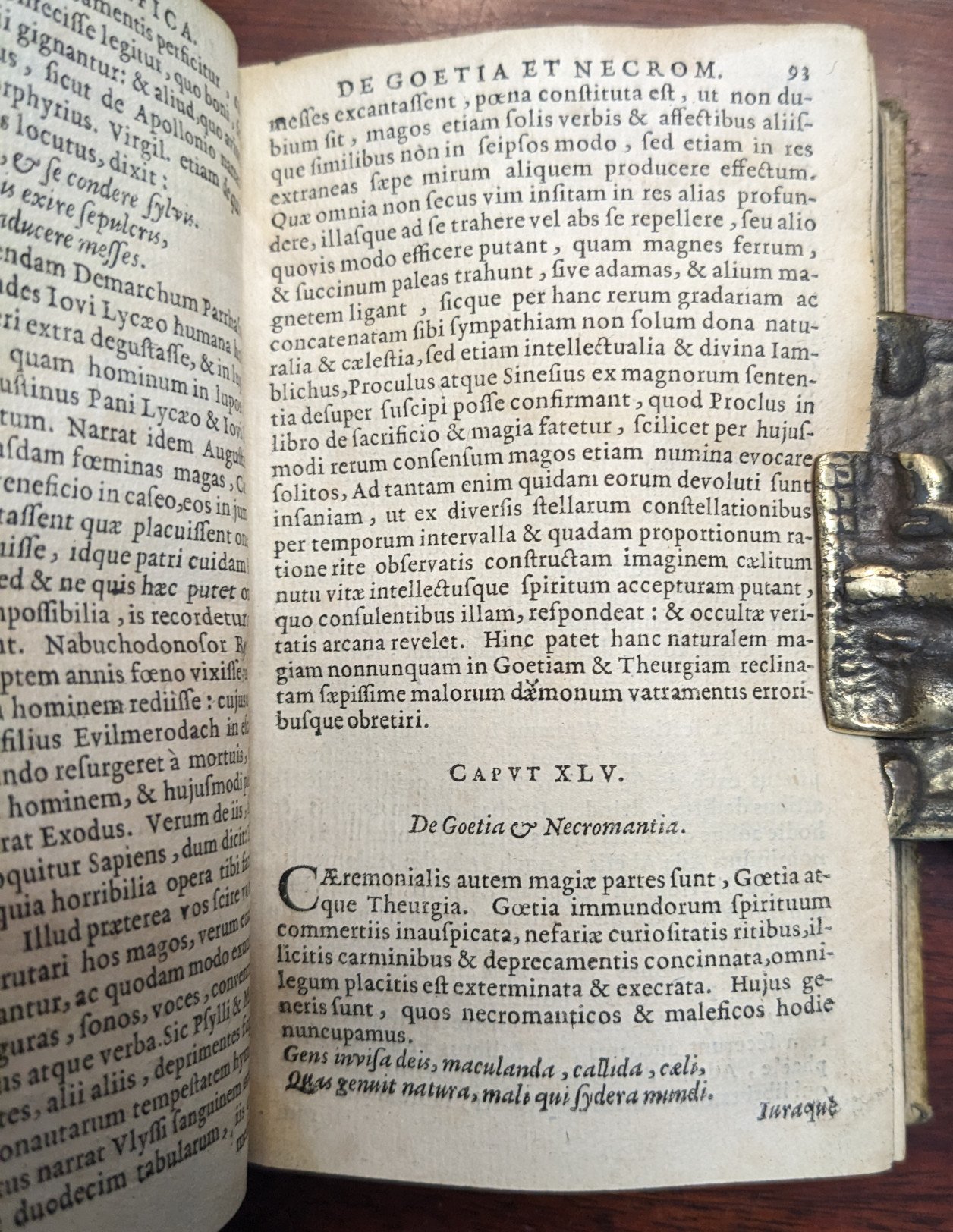 Image 1 of 6
Image 1 of 6

 Image 2 of 6
Image 2 of 6

 Image 3 of 6
Image 3 of 6

 Image 4 of 6
Image 4 of 6

 Image 5 of 6
Image 5 of 6

 Image 6 of 6
Image 6 of 6







1644 - Agrippa's Landmark Work on Kabbalah, Magic and Alchemy
1644. The Vanity of the Sciences: Agrippa's De vanitate and Other Works
This is a Leiden printing from 1644 of Heinrich Cornelius Agrippa von Nettesheim's influential and controversial work, De incertitudine et vanitate scientiarum et artium (On the Uncertainty and Vanity of the Sciences and Arts). First published in 1530, De vanitate is a sweeping and satirical critique of the intellectual pursuits of Agrippa's time, ranging from the natural sciences and mathematics to law, medicine, and even theology. Agrippa, a complex figure who served as a soldier, physician, and occult philosopher, adopts a stance of profound skepticism, arguing for the inherent limitations and ultimate futility of human knowledge when divorced from a deeper spiritual understanding. This edition, published by Severinus Matthaei for the bookselling firms of Abraham Commelinus and Davidis Lopez de Haro in the prominent intellectual center of Leiden, indicates the continued interest in and dissemination of Agrippa's provocative ideas well over a century after their initial publication. Notably, this edition also includes two additional treatises by Agrippa: one on the nobility and excellence of the female sex and another on marriage, demonstrating the broader scope of his intellectual concerns.
The significance of De vanitate within the Western esoteric tradition lies in its complex relationship with occult philosophy and Hermetic thought, for which Agrippa is also renowned, particularly through his De occulta philosophia libri tres. While seemingly a work of radical skepticism, De vanitate can also be interpreted as a purification of the intellect, clearing away what Agrippa perceived as the arrogance and limitations of purely rational and materialistic approaches to knowledge. By highlighting the uncertainties and contradictions within established systems of learning, he implicitly creates space for alternative forms of knowing, including intuitive wisdom and spiritual insight. This critique resonated with later esoteric thinkers who sought to transcend the limitations of conventional science and philosophy in their pursuit of hidden truths about the cosmos and the self. The juxtaposition of this skeptical work with his writings on occult philosophy reveals a nuanced intellectual landscape where the critique of superficial knowledge could pave the way for deeper, more esoteric understanding.
Furthermore, the very act of questioning established authorities and intellectual paradigms, as Agrippa does so vehemently in De vanitate, became a characteristic of certain streams within Western esotericism. His work contributed to a climate of intellectual ferment that encouraged the exploration of alternative knowledge systems and challenged the dominant Aristotelian scholasticism of the era. This edition, therefore, serves as an important historical artifact, illustrating the ongoing engagement with Agrippa's multifaceted intellectual legacy and its enduring relevance to those interested in the historical intersections of skepticism, philosophy, and the Western esoteric tradition. The inclusion of his treatises on women and marriage also offers valuable insights into the social and intellectual currents of the 16th and 17th centuries.
Agrippa von Nettesheim, Heinrich Cornelius. Henrici Cornelii Agrippae ab Nettesheym, De incertitudine & vanitate omnium scientiarum & artium liber, lectu plane jucundus & elegans. Cum adjecto indice Capitum. Accedunt duo ejusdem Auctoris libelli; quorum unus est de Nobilitate & praecellentia foeminei sexus, ejusdemque supra virilem eminentia; Alter de matrimonio seu conjugio, lectu etiam jucundissimi. Lugduni Batavorum [Leiden]: Excudebat Severinus Matthaei, Pro Officinis Abrahami Commelini & Davidis Lopez de Haro. Small octavo. [2] 3 page Life of Agrippa. 8pp Preface. 359 pp. [1]. Latin. Features a title page with a decorative woodcut vignette. Includes woodcut initials and headpieces. Marginalia on blanks. Period vellum over boards. Some bumping and wear. Overall excellent condition.
1644. The Vanity of the Sciences: Agrippa's De vanitate and Other Works
This is a Leiden printing from 1644 of Heinrich Cornelius Agrippa von Nettesheim's influential and controversial work, De incertitudine et vanitate scientiarum et artium (On the Uncertainty and Vanity of the Sciences and Arts). First published in 1530, De vanitate is a sweeping and satirical critique of the intellectual pursuits of Agrippa's time, ranging from the natural sciences and mathematics to law, medicine, and even theology. Agrippa, a complex figure who served as a soldier, physician, and occult philosopher, adopts a stance of profound skepticism, arguing for the inherent limitations and ultimate futility of human knowledge when divorced from a deeper spiritual understanding. This edition, published by Severinus Matthaei for the bookselling firms of Abraham Commelinus and Davidis Lopez de Haro in the prominent intellectual center of Leiden, indicates the continued interest in and dissemination of Agrippa's provocative ideas well over a century after their initial publication. Notably, this edition also includes two additional treatises by Agrippa: one on the nobility and excellence of the female sex and another on marriage, demonstrating the broader scope of his intellectual concerns.
The significance of De vanitate within the Western esoteric tradition lies in its complex relationship with occult philosophy and Hermetic thought, for which Agrippa is also renowned, particularly through his De occulta philosophia libri tres. While seemingly a work of radical skepticism, De vanitate can also be interpreted as a purification of the intellect, clearing away what Agrippa perceived as the arrogance and limitations of purely rational and materialistic approaches to knowledge. By highlighting the uncertainties and contradictions within established systems of learning, he implicitly creates space for alternative forms of knowing, including intuitive wisdom and spiritual insight. This critique resonated with later esoteric thinkers who sought to transcend the limitations of conventional science and philosophy in their pursuit of hidden truths about the cosmos and the self. The juxtaposition of this skeptical work with his writings on occult philosophy reveals a nuanced intellectual landscape where the critique of superficial knowledge could pave the way for deeper, more esoteric understanding.
Furthermore, the very act of questioning established authorities and intellectual paradigms, as Agrippa does so vehemently in De vanitate, became a characteristic of certain streams within Western esotericism. His work contributed to a climate of intellectual ferment that encouraged the exploration of alternative knowledge systems and challenged the dominant Aristotelian scholasticism of the era. This edition, therefore, serves as an important historical artifact, illustrating the ongoing engagement with Agrippa's multifaceted intellectual legacy and its enduring relevance to those interested in the historical intersections of skepticism, philosophy, and the Western esoteric tradition. The inclusion of his treatises on women and marriage also offers valuable insights into the social and intellectual currents of the 16th and 17th centuries.
Agrippa von Nettesheim, Heinrich Cornelius. Henrici Cornelii Agrippae ab Nettesheym, De incertitudine & vanitate omnium scientiarum & artium liber, lectu plane jucundus & elegans. Cum adjecto indice Capitum. Accedunt duo ejusdem Auctoris libelli; quorum unus est de Nobilitate & praecellentia foeminei sexus, ejusdemque supra virilem eminentia; Alter de matrimonio seu conjugio, lectu etiam jucundissimi. Lugduni Batavorum [Leiden]: Excudebat Severinus Matthaei, Pro Officinis Abrahami Commelini & Davidis Lopez de Haro. Small octavo. [2] 3 page Life of Agrippa. 8pp Preface. 359 pp. [1]. Latin. Features a title page with a decorative woodcut vignette. Includes woodcut initials and headpieces. Marginalia on blanks. Period vellum over boards. Some bumping and wear. Overall excellent condition.
